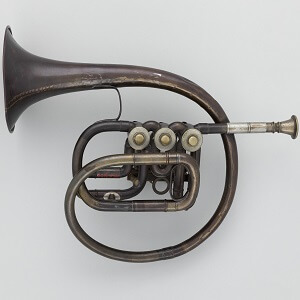Soprano Helicon
 Helicon, a large, valved bass brass instrument that is a member of the tuba family. Developed in 1845 by Ignaz Stowasser of Vienna, it has a spiral circular form that allows the helicon’s bell (the flared end of the instrument) to rest on the player’s left shoulder and, thus, makes the instrument relatively easy to carry in marching or horseback military bands, for which it was designed. The helicon was the basis of the sousaphone—named for its inventor, American bandmaster John Philip Sousa.
Helicon, a large, valved bass brass instrument that is a member of the tuba family. Developed in 1845 by Ignaz Stowasser of Vienna, it has a spiral circular form that allows the helicon’s bell (the flared end of the instrument) to rest on the player’s left shoulder and, thus, makes the instrument relatively easy to carry in marching or horseback military bands, for which it was designed. The helicon was the basis of the sousaphone—named for its inventor, American bandmaster John Philip Sousa.
The design of the modern Soprano Helicon takes acoustical advantage of the helicon's easy blowing, but is not simply another circular Petite Bugle or Soprano Cornet. The helicon clearly has a larger bore and wider tapered conical tube with a large bell for the instrument of its size. The pitch of E♭₄ was deliberately chosen, so that musicians can easily play the soprano line within the middle register of the instrument going mostly up to G₅. E♭₄ was also chosen for its open and piercing nature within the pitched bass winds since it was intended for the Soprano Helicon to become a first and leading voice of the family.